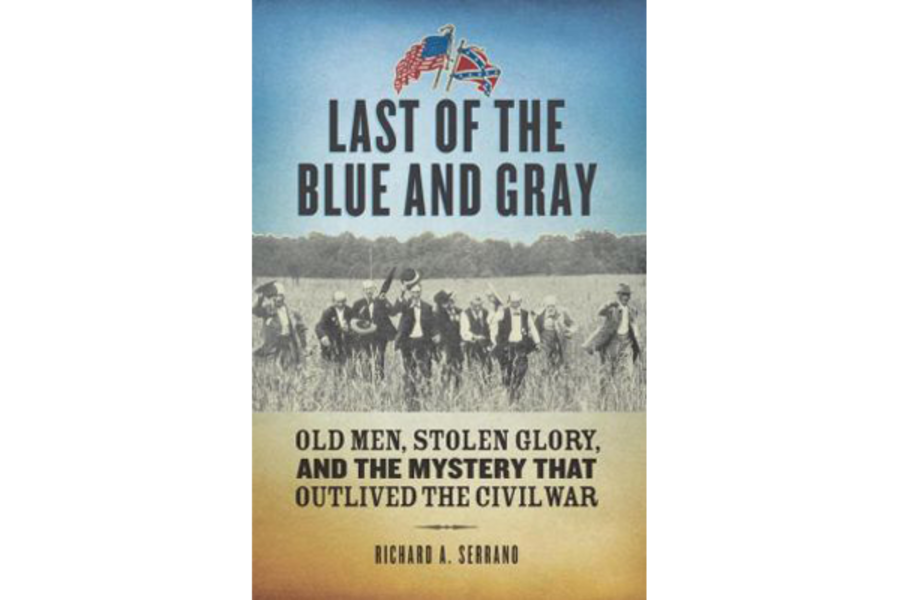For last Civil War vets, a time of fraud and honor
Loading...
As the US Civil War neared its 100th anniversary in the late 1950s, plenty of Americans kept their eyes on a handful of veterans who'd already passed the century mark themselves. They were the last men who'd fought for North and South, and pretty soon there'd be only one left, a final living symbol of the war between the states.
These grizzled old men spent their days greeting reporters and local schoolchildren, wowing physicians with their longevity, and monitoring each other's status. And as much as they could – for they were each well past 100 – they remembered their service.
It's a lovely story about remembrance and the passage of time. Or so it seems until you look closer.
Many of these elderly men were frauds, seeking fame or money or just a chance to become something other than ordinary. But which vets were fake and which were real? And how do you even find out who legitimately fought in a long-ago war?
Richard Serrano, a longtime Washington correspondent for the Los Angeles Times, chronicles the final days of the Civil War veterans – genuine and otherwise – in his new book "Last of the Blue and Gray: Old Men, Stolen Glory and the Mystery that Outlived the Civil War."
In an interview, Serrano talked about the origins of his book, the myriad motives of those who lied, and the legacy of these real and imagined heroes.
Q: How did you come across the topic of the veterans of the Civil War?
A: I live in Virginia, and there's a statue in Alexandria of a Confederate soldier. This statue marks the spot where they would muster the young men from Alexandria to go off and fight the war. He's about middle age, and he's got his back to the north and is facing south. His arms are crossed and his head is bowed in defeat.
I've always loved that statue. Who was that guy and whatever became of him?
A lot of counties have had to move these statues because of sensitivities regarding African-Americans. They moved them into museums or cemeteries. But this one is still there as a memorial to the war dead.
I wanted to write a book about the long arc of time after the war, and thought I'd focus on one regiment, or one battle, and discover whatever happened to those guys: How'd they grow old, how'd they deal with their wounds and live on?
Then I wondered who were the very last guys on each side.
Q: How did you go about finding and verifying those who seemed to be the last-living veterans?
A: I thought I'd have a nice book about the last two guys.
The last Yankee was easy to find. He was the last of the Grand Army of the Republic, and there's a famous statue made of him to celebrate the typical Union soldier. He died in 1956.
But the Southern guys were more difficult. There were half a dozen well into the 1950s.
Each state had their pension rolls, so I'd call the state capitals and start pulling those files. As I got into it, I began to realize that some of them, particularly the Southerners, were total frauds.
I was amazed and realized I had a whole different story.
Q: What were the fake veterans after?
A: They were after money, or celebrity, or being someone of consequence.
They were real celebrities in little towns, real local heroes. And veterans pensions brought out a lot of these guys.
There was also a sense that there was nothing in their lives, in their times, that could surpass what the Civil War was. Much like with World War II, guys who couldn't go felt terrible they couldn't participate in that.
Q: How do you think some of these lies began?
A: Some of it begins as a lark. But once you commit the lie, you've got to continue to build on that lie. That lie has to be your life, and you have to continue to live it.
You can't go to the big celebrations, the big Confederate parades, and say, "Wait a minute, I made all this up." That's a tragedy. They've got to know in their hearts this is all made up.
Q: How did the veterans – real and fake – fit into the era of the 1950s?
A: You think about the 1950s, and World War II was over. You had this flood of veterans coming back, and here were these old guys. At some point, we'd be like them. The idea was that if we honor our Civil War veterans, we'll honor all veterans.
They were hometown heroes, curiosities of an older time. Now you had airplanes, telephones, and cars. They were from a bygone time that just amazed people.
Q: What's the legacy of your story?
A: There's a dark side of human nature that surfaces with these kinds of things. We already see it with some Vietnam veterans. On the good side are the stories about honor, courage, and sacrifice from 150 years ago.
I just love the characters, They were fun, full of mischief, and getting away with things. They were 100 years old but acting like 14-year-old boys.







